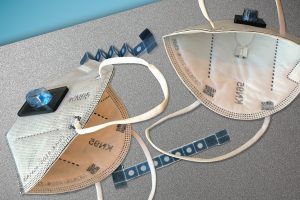
New face mask prototype can detect COVID-19 infection
Canadian Plastics
Materials Research & Development COVID-19Developed by researchers at Harvard and MIT, the mask's sensor technology could also be used to create clothing that detects a variety of pathogens and other threats.

Photo Credit: Felice Frankel and MIT News Office
Engineers at MIT and Harvard University, both in Massachusetts, have designed a novel face mask that’s embedded with tiny, disposable sensors that can diagnose the wearer with COVID-19 within about 90 minutes.
And the sensors can also be fitted into other face masks and could also be adapted to detect other viruses.
The sensors are based on freeze-dried cellular machinery that the research team has previously developed for use in paper diagnostics for viruses such as Ebola and Zika. In a new study, the researchers showed that the sensors could be incorporated into not only face masks but also clothing such as lab coats, potentially offering a new way to monitor health care workers’ exposure to a variety of pathogens or other threats.
“We’ve demonstrated that we can freeze-dry a broad range of synthetic biology sensors to detect viral or bacterial nucleic acids, as well as toxic chemicals, including nerve toxins. We envision that this platform could enable next-generation wearable biosensors for first responders, health care personnel, and military personnel,” said James Collins, the Termeer Professor of Medical Engineering and Science in MIT’s Institute for Medical Engineering and Science (IMES) and Department of Biological Engineering.
Based on technology that Collins began developing several years ago, the face mask sensors are designed so that they can be activated by the wearer when they’re ready to perform the test, and the results are only displayed on the inside of the mask, for user privacy.
The origins of the mask go back to before the pandemic, when Collins and his colleagues began working on incorporating these sensors into textiles, with the goal of creating a lab coat for health care workers or others with potential exposure to pathogens; and the one that was the best was a combination of polyester and other synthetic fibres. To make wearable sensors, the researchers embedded their components into a small section of this synthetic fabric, where they’re surrounded by a ring of silicone elastomer – this compartmentalization prevents the sample from evaporating or diffusing away from the sensor.
To demonstrate the technology, the researchers created a jacket embedded with about 30 of these sensors; they showed that a small splash of liquid containing viral particles, mimicking exposure to an infected patient, can hydrate the freeze-dried cell components and activate the sensor. The sensors can be designed to produce different types of signals, including a colour change that can be seen with the naked eye, or a fluorescent or luminescent signal, which can be read with a handheld spectrometer. The researchers also designed a wearable spectrometer that could be integrated into the fabric, where it can read the results and wirelessly transmit them to a mobile device.
As the researchers were finishing up their work on the wearable sensors early in 2020, COVID-19 began spreading around the globe, so they quickly decided to try using their technology to create a diagnostic for the SARS-CoV-2 virus. To produce their diagnostic face mask, the researchers embedded freeze-dried sensors into a paper mask. As with the wearable sensors, the freeze-dried components are surrounded by silicone elastomer. In this case, the sensors are placed on the inside of the mask, so they can detect viral particles in the breath of the person wearing the mask.
The mask also includes a small reservoir of water that’s released at the push of a button when the wearer is ready to perform the test. This hydrates the freeze-dried components of the SARS-CoV-2 sensor, which analyzes accumulated breath droplets on the inside of the mask and produces a result within 90 minutes.
The prototypes developed in this study have sensors on the inside of the mask to detect a user’s status, as well as sensors placed on the outside of garments, to detect exposure from the environment. The researchers can also swap in sensors for other pathogens, including influenza, Ebola, and Zika, or sensors they have developed to detect organophosphate nerve agents.
The researchers have filed for a patent on the technology and they are now hoping to work with a company to further develop the sensors. The face mask is most likely the first application that could be made available, Collins said. “I think the face mask is probably the most advanced and the closest to a product,” he added. “We have already had a lot of interest from outside groups that would like to take the prototype efforts we have and advance them to an approved, marketed product.”
The research was funded by the Defense Threat Reduction Agency; the Paul G. Allen Frontiers Group; the Wyss Institute; Johnson and Johnson Innovation JLABS; the Ragon Institute of MGH, MIT and Harvard; and the Patrick J. McGovern Foundation.
